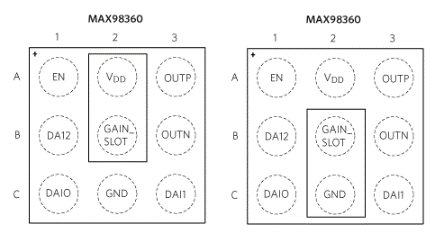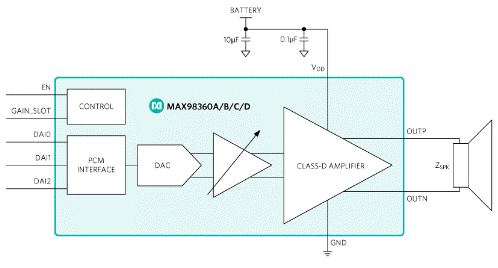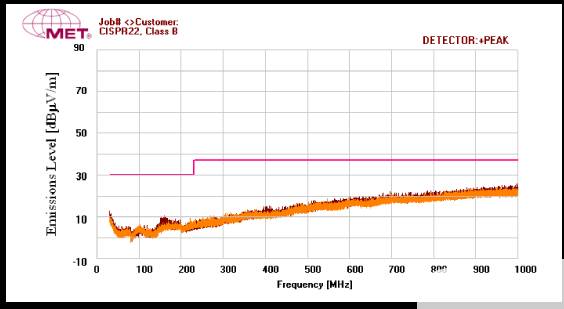The IC shown in Figure 3 solves all aspects of these design problems, and has the additional advantage of providing simpler, smaller and lower power consumption solutions.
Figure 3. MAX98360 Digital Class D Amplifier
Unlike the old Class D amplifier, this IC uses automatic sampling rate and bit depth configuration, without complex programming, and provides a simple and effective "plug and play" audio solution. It has flexible audio interface and supports I2S, left-aligned and 8-channel time division multiplexing (TDM) data formats. It accepts sampling rates of 8kHz, 16kHz, 32kHz, 44.1kHz, 48kHz, 88.2kHz and 96kHz. The data word in I can be 16-bit, 24-bit or 32-bit 2S and left-aligned mode and 16-bit or 32-bit in TDM mode. ten μ V guarantees high-quality audio RMS output noise, 80dB PSRR and 110dB dynamic range specifications, which are particularly important for devices with speakers close to the ear (such as AR/VR and wearable devices) and devices used in quiet environments (sleep aids).
Compared with other Class D amplifiers, this amplifier has many power advantages. It can only work with one power supply voltage (2.5V to 5.5V). It can accept input logic voltage levels as low as 1.2V (which means no level converter is required), but it is strong enough to withstand input voltage as high as 5.5V. It also operates at up to 92% efficiency, thereby reducing battery consumption.
Another beneficial feature is that if the DAIn pin remains low, the IC will automatically enter the ultra-low power consumption mode. In this mode, the IC absorbs 1.5 μ A‘s tiny standby current. This greatly reduces power consumption, which is very useful in applications where no host GPIO can be used to control the EN pin. However, it should be noted that the EN pin can be used to achieve additional energy saving effect by placing the IC in the off mode. In this mode, the IC only consumes 15nA current.
Conveniently, it also has a very fast 1ms turn-on time (4 times faster than similar Class D amplifier). Even when connected to the LRA haptic driver, it can achieve an ultra-low power consumption of 1.5 μ A Wait in standby mode.
The IC also has some other significant advantages, helping to minimize the size/cost of the circuit board. First of all, it has a tiny size of 1.9 mm. The 29-pin WLP has an ingenious pin layout designed to eliminate the need for vias on expensive circuit boards. As shown in Figure 4, GAIN_ The SLOT pin (located in the center of the package) can be easily connected to VDD or GND (directly or using a resistor) or left unconnected to provide I2S/left-aligned gain settings as shown in Table 1.

Figure 4. Add GAIN_ SLOT is connected to VDD or GND for the desired gain setting.
|
GAIN_SLOT
|
I 2S/left aligned gain (dB)
|
|
Connect to ground
|
12
|
|
irrelevant
|
9
|
|
Connect to VDD
|
6
|
|
Connected to VDD (through 100kO resistor)
|
3
|
|
Connected to ground (through 100kO resistance)
|
-3
|
Secondly, the device can achieve the excellent EMI performance shown in Figure 5 without additional Class D filtering. Since only one external bypass capacitor is required, the overall solution size is only 3.69mm2
Figure 5. MAX98360 EMI performance with 12-inch stripline load.
summary
With audio interface rapidly becoming a common function of battery-powered wearable devices, Internet of Things devices and other types of small portable electronic devices, designers are looking for simpler and more cost-effective ways to add high-quality audio to their devices. In this design solution, we reviewed the difficulties of integrating some Class D amplifiers into space-constrained applications. We can conclude that the new generation of flexible low-power digital input Class D audio amplifier brings "plug and play" simplicity to the task of integrating audio into any type of electronic device, making it an ideal choice for portable devices, wearable devices and Internet of Things devices. In addition to the 9-pin WLP package, the MAX98360 also provides 10-pin FC2QFN package.
|
Disclaimer: This article is transferred from other platforms and does not represent the views and positions of this site. If there is any infringement or objection, please contact us to delete it. thank you!
中恒科技ChipHomeTek
|



